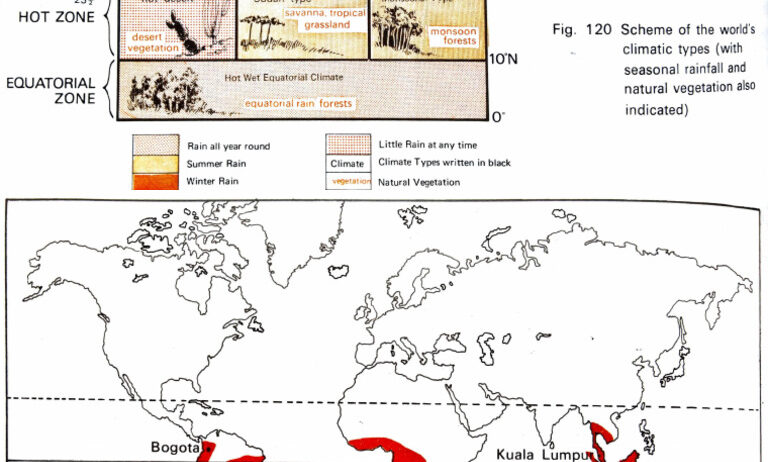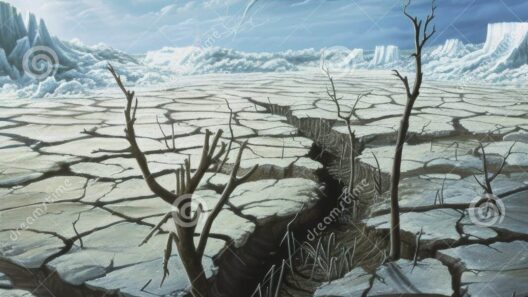Climate, a multifaceted phenomenon, encompasses the long-term patterns of temperature, humidity, wind, and precipitation in a given area. Understanding the various types of climate is essential for grasping the complexities of our ecosystems and the impacts of climate change. This discourse elucidates the different climatic zones found around the globe and highlights their distinctive characteristics, distributions, and ecological implications.
Major climatic categories are typically classified under the Köppen Climate Classification system, which is one of the most widely utilized systems in climatic studies. This system classifies climates into five main types: tropical, arid, temperate, continental, and polar. Each of these categories can be further subdivided into subtypes, allowing for a comprehensive understanding of climatic variability.
Tropical Climates
Tropical climates, characterized by consistently high temperatures and significant precipitation, are predominantly located near the equator. These climates can be further subdivided into three subcategories: tropical rainforest, tropical savanna, and tropical monsoon.
The tropical rainforest climate is found in regions like the Amazon Basin, the Congo Basin, and Southeast Asia. These areas experience abundant rainfall, exceeding 2000 millimeters annually, and have high humidity. The resulting dense vegetation supports a rich biodiversity, including countless species of plants, animals, and microorganisms, many of which are endemic to these rainforests.
In contrast, the tropical savanna climate features a distinct wet and dry season but maintains high temperatures year-round. This climate is typically found in regions such as parts of Africa, northern Australia, and parts of South America. The dry season leads to the growth of savannas or grasslands, which become home to a variety of herbivorous animals, and subsequently, their predators.
The tropical monsoon climate is characterized by a short dry season and a prolonged wet season. Regions such as the Indian subcontinent and parts of Southeast Asia exemplify this climate. The rainy season is crucial for agriculture, but the intense monsoonal rains can also lead to flooding.
Arid Climates
Arid climates, often referred to as desert climates, are defined by their low precipitation levels, typically less than 250 millimeters per year. They can be subdivided into hot deserts and cold deserts. The hot desert climate is prevalent in regions such as the Sahara Desert, the Arabian Peninsula, and southwestern United States, where daytime temperatures soar excessively, while nights can be markedly cooler. Vegetation in these areas is sparse and adapted to conserve water, featuring succulents like cacti and drought-resistant shrubbery.
Conversely, cold desert climates experience cooler temperatures and are found in areas like parts of Mongolia and the great basin of the United States. These regions have relatively warm summers but frigid winters, with vegetation adapted to endure harsh cold snaps.
Temperate Climates
Temperate climates, known as moderate climates, exhibit four distinct seasons: spring, summer, autumn, and winter. They are primarily located between the tropics and polar regions, with variances based on geographical features. The two primary forms are the Mediterranean and humid subtropical climates.
The Mediterranean climate is characterized by dry summers and rainy winters. Regions like coastal California, the Mediterranean Basin, and parts of Australia are prime examples. This climate supports vineyards, olive groves, and diverse wildlife, greatly contributing to local economies through agriculture and tourism.
On the other hand, the humid subtropical climate has hot, humid summers and mild winters. This climate can be found in the southeastern United States, eastern Asia, and parts of South America. The abundant rainfall supports dense forests and agricultural crops, including rice and cotton, which thrive in this warm, moist environment.
Continental Climates
Continental climates are marked by significant temperature variations between seasons, with hot summers and cold winters. These climates predominantly occur in the interior regions of continents, such as in the central United States and parts of Eastern Europe.
Subtypes include the humid continental climate, where winters can be severe. This type is typically found in northeastern U.S. and parts of Canada, producing diverse ecosystems and extensive deciduous forests. The semiarid climate, another subtype, experiences less precipitation than its humid counterpart but still allows for seasonal vegetation.
Polar Climates
Polar climates, found at the poles and high altitude regions, are characterized by frigid temperatures throughout the year and very little precipitation. These climates can be divided into the tundra and ice cap subtypes. The tundra climate, found in parts of Alaska, Canada, and Russia, hosts a unique ecosystem where only short grasses and moss can survive. The harsh temperatures and brief growing seasons limit biodiversity.
In contrast, the ice cap climate remains perpetually covered by ice, found in areas such as Antarctica and Greenland, where life is sparse. The extreme conditions pose significant challenges to ecological systems and severely limit human habitation.
In summary, acumen regarding the different types of climates is indispensable for understanding global environmental challenges. From the lush biodiversity of tropical rainforests to the stark desolation of polar ice caps, each climate influences the earth’s natural habitats, resources, and human activities. Awareness of these climatic zones can enlighten efforts in conservation, agriculture, and climate adaptability as we navigate the escalating impacts of climate change.








